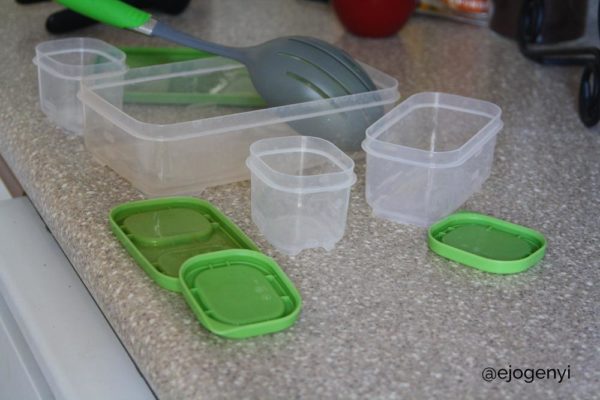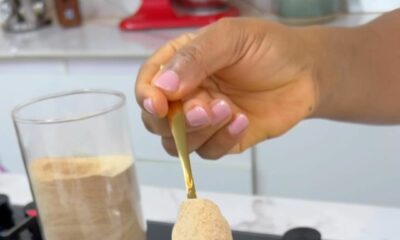Features
Ej Ogenyi: How to Count Calories in Nigerian Food
 When you’re trying to manage your weight you have the choice of changing your eating habits, exercising, and/or both. The options mentioned above are all ways of balancing calories to get to your goal, and this balance is what makes the difference in what you weigh and here’s what this looks like:
When you’re trying to manage your weight you have the choice of changing your eating habits, exercising, and/or both. The options mentioned above are all ways of balancing calories to get to your goal, and this balance is what makes the difference in what you weigh and here’s what this looks like:
- To lose the weight – eat FEWER calories than your body burns
- To maintain your weight – eat NO MORE than your body burns
- To gain weight – eat MORE calories than your body burns
There are equations and online calculators to estimate the amount of calories your body burns based on your current height, weight, and a factor for your activity level.
On the other end of the equation, you need to pay attention to what you eat to estimate the number of calories you’re eating. But if you love to eat Nigerian food, this can be a challenge since most of the information available about our food is either non-existent, inconsistent, or just plain incorrect.
Even if you had the patience of the Pope, this triple threat of issues can leave you frustrated and ready to throw in the towel. Plus having 100% reliable the calorie information doesn’t guarantee consistent calorie information across the board, because every home chef has her own unique way of doing things. All of this can make for a lot of challenges if you don’t cook everything you put in your mouth.
Today, I’m here to tell you that you don’t have to give up just yet; rather you need to shift your focus from trying to find and quantify the calories in our delicious Nigerian fare to tracking your eating habits.
Here’s the four-step process that will help you do just that:
Step One: Come Up with Your Standard
This step is where you choose a way of measuring your food. You can choose to use measuring cups or you can have designated serving and eating dishes. Here is a list of three ideas that you can use to create your standard:
- Use the same set of measuring spoons when serving yourself at home. This way you can note your food intake in terms of that serving spoon. This makes to make adjustments when you want to cut down or ramp up your food intake.
- Create a serving system for eating out: When you eat out, come up with a way to measure your portions. Examples include splitting your plate i.e. ½ of your plate is for starchy food and the other half for vegetables. To help you with this, ask your server for a separate plate and re-serve your food just how you like it.
- Have a fixed lunch plate for work: Having a special lunch bowl makes it easy for you to quantify what you eat, especially if you know the capacity of the plate.
Pick a serving spoon (or spoons) and specific lunch plates (LunchBlox shown) to standardize how you serve your food
I use a combination of 1 and 3 (the LunchBlox system by Rubbermaid shown above) and I can tell you that having a standard gives you an easy way of keeping track of your meals when you come to the next step. This helps you understand and adjust your food intake based on how your body responds and not based on calorie intake estimates that you can’t rely on 100%.
Step Two: Keep Track of Your Meals in a Food Journal
Once you have your personal way of measuring your food, you need to keep track of it using a food journal. You can’t change what you don’t measure, and keeping a food journal will help you measure you food intake and connect how your body responds to how you eat. Using descriptions that are related to your standard from Step One will help make your journal truly yours and allow you to easily make changes to your meals if you find the need to do so.
If you need a template for a food journal, I’ve created just the thing for you. It’s the [TEAM] Food Journal Template and you can use it as it is or for inspiration. If you don’t have it yet, click here to enter your email address and your first name so that I can send you a copy.
Step Three: Keep Track of Your Weight
If you’re still reading this, I feel safe in assuming that you’re serious about using a healthy and balanced diet to manage your weight. Since this is what you’re trying to change, then you need to make sure you check your weight. Before you protest that you don’t want the scale to dictate your life, I understand the impulse to not want to look at it. But.
Remember the scale is a machine that is reading what your body weighs and nothing more. The number on the scale isn’t who you are and it doesn’t have any relationship to whether you’ve been “good” or “bad.” The number on the scale is just what you weigh on any given day and it changes based on what you eat, how much water you’ve drank, and how much you’ve moved on any particular day.
Your weight can fluctuate anywhere from 0 – 5 lbs (0 – 2 kg) on one day to the next, so here are some guidelines to keep yourself from going crazy about the number changes:
- Weigh yourself at the same time each week
- Do it in the same clothes (or no clothes at all if you have a scale in your bathroom)
- Take it seriously only once a week. There’s really no use getting worked up by weighing yourself everyday (I did this once in my storied dieting history and it drove me absolutely crazy)
Step Four: Refer Back to Your Journal
Having a standard, keeping a food journal, and keeping track of your weight are pointless if you don’t use the information you collect. When you observe a weight trend that you want to change, your food journal should be the first place you go before consulting a different plan.
If the numbers on the scale go down, go back to your journal to study how you’re eating to see if you can keep eating that way to continue to see progress. If your numbers go up, check your journal and to see where you can make easy cuts that won’t make you feel deprived. Start small and see how your body responds.
One word of caution is that you should give any new changes in your eating pattern at least 2 weeks to really give it a chance to work. I’ll say to give it a month.
If you read the headline and were expecting an easy calorie counting method for Nigerian food, I apologize if you feel misled. But using this method of tracking your meals and how your body responds is an investment in yourself that’ll pay dividends and save you a lot of headache. Really make it personal rather than going for the latest diet and you’ll definitely find yourself enjoying our cultured Nigerian meals and still trim your waistline.

























